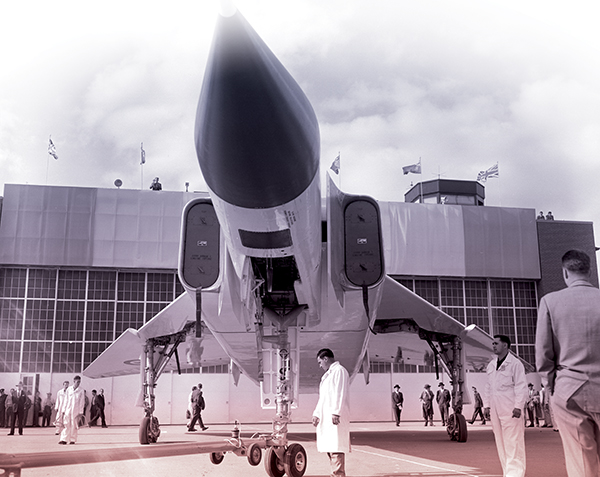
When the first CF-105 was rolled out, it was “potentially the fastest fighter that the world has yet seen,” according to Flight magazine. [Walter Curtin/Business Week/LAC/3837035]
Brilliant and blazingly fast, the CF-105 was ahead of its time—and short-lived
During the height of the Cold War in the 1950s, there was a growing concern that Soviet bombers would attack North America via the shortest route, over the Canadian Arctic. NATO intelligence suggested that such an attack could occur as early as 1954.
So, in 1953, the Royal Canadian Air Force commissioned the A.V. Roe Canada Ltd. aircraft manufacturing company in Malton, Ont., to design and build a fighter plane that could operate in any weather, fly at twice the speed of sound, execute a 2G turn at 50,000 feet without losing speed or altitude, and fire a missile at oncoming bombers. It was, at the time, the most demanding specification in the world, and many international manufacturers believed it couldn’t be done.
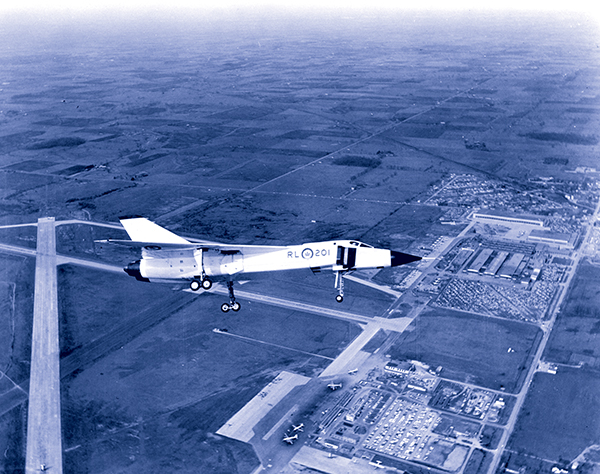
Test flights were conducted in 1958. [DND]
It was unique from the start. Instead of having traditional wings like the American F-86 Sabre or the Soviet MiG-15, the Arrow used a delta-shaped wing, like the French Mirage fighter jet.
The Arrow was also to be the first plane fitted with new, lightweight engines made of titanium. The first five aircraft were tested using conventional Pratt & Whitney J75 turbojet engines and the sixth was to be outfitted with Orenda PS.13 Iroquois titanium engines made by Orenda Engines, the other A.V. Roe aviation subsidiary, also in Malton.

The first Arrow was rolled out for the press to see on Oct. 4, 1957. The plane stunned the aviation world. Flight magazine called it “the biggest, most powerful…and potentially the fastest fighter that the world has yet seen.”
“This fighter, in almost every way the most advanced of all the fighters of the 1950s, was as impressive and successful as any aircraft in history,” said British aviation expert Bill Gunston.
The first Arrow—RL-201 (RL stands for Roe Limited)—took its first test flight on March 25, 1958. It flew for 35 minutes above Toronto and landed safely. On its third test flight, on April 3, the Arrow broke the speed of sound—Mach 1—and then went supersonic. It did this while it was still climbing—at a time when aircraft typically could only break the sound barrier in a dive.
Test pilot Janusz Żurakowski flew RL-202 at Mach 1.89 (2,330 kilometres per hour) on Sept. 14, 1958. That November, pilot Wladyslaw (Spud) Potocki flew RL-202 at Mach 1.95 (2,408 kilometres per hour) in a slight dive. And this was without the Iroquois engines, which were 2,270 kilograms lighter than the J75s.
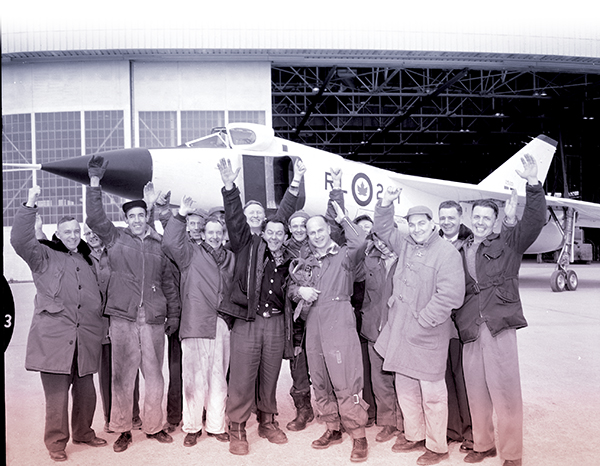
Avro line crew congratulate test pilot Janusz Żurakowski. [Avro Canada/Canada Aviation and Space Museum]
On Aug. 26, 1957, the Soviet Union announced it had successfully tested an intercontinental ballistic missile (ICBM), claiming it could hit a target in “any part of the world,” including North America.
On Oct. 4, 1957, the same day the Arrow was unveiled to the world, the first Soviet satellite, Sputnik 1, circled the globe.
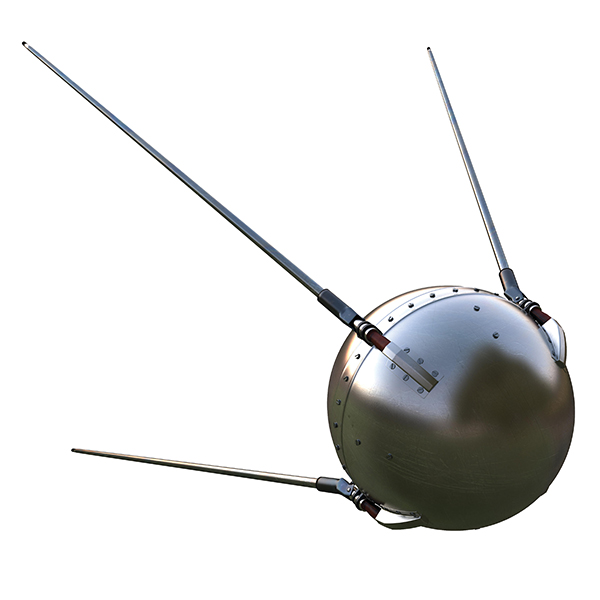
The launch of Sputnik 1, the first artificial Earth satellite, changed the Cold War playing field. [Vitaliy Gaydukov/Alamy/RHH52K]
Six days after the Arrow’s first test flight, Prime Minister John Diefenbaker’s Conservative Party was re-elected with a majority government on the platform of promising to lower taxes and reduce government spending. The Arrow, meanwhile, was getting expensive.
The estimate to make the first 37 Arrows was $350 million, or almost $9.5 million per plane, taking into account start-up costs for building the factories, making the equipment and tools, training personnel, and test flying the aircraft. This would make the Arrow the most expensive aircraft in the world.
On Feb. 20, 1959, Diefenbaker stood in the House of Commons and made the announcement to cancel the Arrow. Within the Canadian aviation industry, this day became known as “Black Friday.”
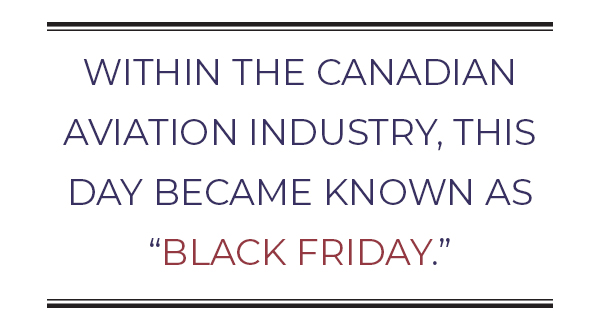
The government was cancelling production of the Arrow and the Iroquois engines immediately, Diefenbaker announced, because of the change “in the attitude of the Soviet Union in devoting itself more and more to missiles…. By 1962, [the Arrow] will be ineffective.”
Instead of funding the Arrow to counter the Soviet threat, the government had decided to purchase the American Bomarc long-range surface-to-air missile defence system. Overnight, more than 14,000 employees of Avro Aircraft and Orenda Engines were unemployed.
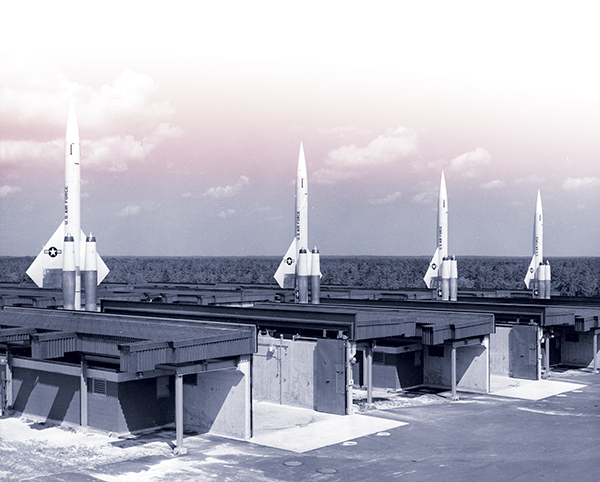
Four Bomarc IM-99A anti-aircraft missiles near McGuire Air Force Base in New Jersey. Each missile could carry a 6.5-kilotonne nuclear warhead. [National Museum of the U.S. Air Force/090603-F-1234P-002/Wikimedia]
What happened next was one of the biggest mysteries surrounding the Arrow: who ordered the scrapping and why? Sure, no more planes were going to be built, but there were five completed Arrows and the sixth was nearly finished.
On March 26, 1959, Air Marshal Hugh Campbell sent a memo to George Pearkes, Minister of National Defence. In it, he recommended that the government should “reduce it to scrap.”
The reason for this was that if they did not destroy them, they could be sold intact and sometime in the future the “airframe and engine could conceivably be placed on public view or even, in fact, used as a roadside stand,” which would cause “subsequent embarrassment.”
The minister agreed to the idea of scrapping the plane. Over the next few weeks, blowtorches were taken to the aircraft and they were reduced to scrap metal that was sold to a junk dealer in Hamilton at 6.5 cents a pound.
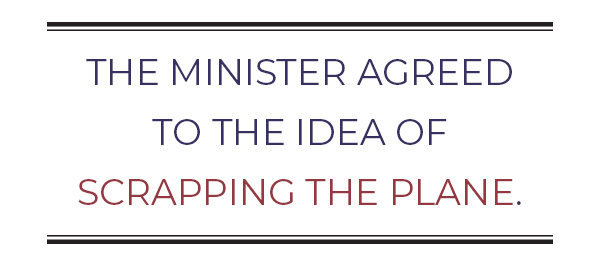
Today, all that is left is the nose and cockpit—the cone section—of RL-206, the outer wing of RL-203, an Iroquois engine, a front landing gear and random other parts in museums. Many of these pieces can be seen at the Canadian Aviation and Space Museum in Ottawa.
It was recently discovered that a senior draftsman, Ken Barnes, took a copy of some of the Arrow blueprints and hid them in his basement rather than destroy them. They remained hidden there until they were discovered by his son after his death in 2019. The partial blueprints are now on display at the Diefenbaker Canada Centre in Saskatoon.
In 1961, the U.S. Air Force admitted that the Soviet bomber threat was still real. This led the Diefenbaker government to purchase 66 aging and less-capable American McDonnell F-101 Voodoo aircraft in June 1961. Bomarc missiles were strategically deployed at bases in North Bay, Ont., and La Macaza, Que., from 1962 to 1972.
But the Bomarc missile system that Canada purchased from the United States was worthless: it would only work if it could carry a nuclear warhead, but the Canadian government refused to allow nuclear warheads on Canadian soil. This flip-flop, cancelling the Arrow only to buy American fighter planes and the worthless Bomarc system, cost the Diefenbaker government the federal election in 1963 to Lester Pearson’s Liberal government.
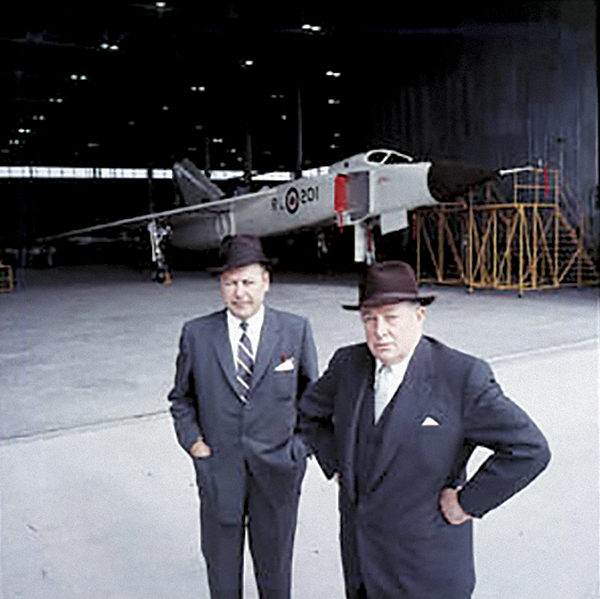
Avro president Crawford Gordon (at left) and managing director Roy Dobson stand in the hangar door with the first Avro Arrow behind them on July 11, 1957. [DND]
In 1992, Canadian researcher Palmiro Campagna wrote in Storms of Controversy: The Secret Avro Arrow Files Revealed that he discovered a meeting was held between Pearkes and American defence secretary Neil McElroy in August 1958. The American delegation suggested, wrote Campagna, that if the Canadian government did not scrap the Arrow and purchase the Bomarc system, then the Americans would place their own Bomarcs south of the Great Lakes.
We know now—and undoubtedly the Canadian team knew then—that the Bomarc was only effective with a nuclear warhead. Use of such a weapon over southern Ontario and Quebec would be catastrophic to Canada.
“In other words,” wrote Campagna, “with the Bomarc’s limited 250-mile range, any attempt at using those missiles would create an air battle over southern Ontario and Quebec…. The threat of such a consequence was tantamount to coercion by the United States: ‘Accept our missile bases or we will give you nuclear devastation over your most populated regions.’
“Pearkes…would have reasoned that the only way to reduce the risk and save these regions would be to have the missile bases moved northward. Accepting the bases, though, would mean the death of the Arrow.”
Despite the official reason that the evolving ICBM threat rendered the interceptor unviable, many have insisted it was the cost of the Arrow that led to its demise—that it was too rich for Canada.
Either way, as historian James Marsh has written, “a sense of pride swept through the nation” when the Arrow flew and “the cancellation [and destruction] of the Arrow was a mortal blow to part of the national dream.”
Perhaps the biggest mystery surrounding the Arrow was whether or not they all were destroyed. A photo taken by a reporter in 1959 shows four of the five Arrows being dismantled on the tarmac. RL-202 is not seen in the photo.
In 1968, Air Marshal Wilfrid Curtis was asked by a Toronto Star reporter if any Arrows still existed. Curtis replied, “I don’t want to answer that.” Then he added cryptically, “If it is in existence, it may have to wait another 10 years [to be revealed.] Politically it may cause a lot of trouble.”
There is no government document stating that all of the Arrows were destroyed. Journalist June Callwood remembers the distinctive sound of an Arrow flying over Toronto the day after the Arrow program was cancelled.
“The Arrow! I thought in amazement. Nothing else could make such a racket. Someone has flown an Arrow to safety,” she wrote in a 1997 Maclean’s article.
A private collector put an authentic Arrow ejection seat up for auction on eBay in 2011. The asking price was $250,000 and the seller lived in England. How did a Canadian aircraft pilot’s seat end up in England?
The myth of “The Missing Arrow” still endures after six decades. Perhaps soon, someone will come forward with definitive, tangible proof—one way or the other—so the mystery can finally be solved. That would, at least, bring some closure to a dramatic episode in the national dream.

Four Avro Arrows are dismantled outside the Avro Canada building at Malton Airport (now Toronto Pearson International Airport) in 1959. [Herb Nott & Co/Lester B. Pearson International Airport/LAC/3596419]
Too rich for Canada?
By Palmiro Campagna
The written government record—which has now been mostly declassified—offers several clues to the motivation behind the Arrow’s cancellation.
“The future of that aircraft will depend entirely on the nature of the threat,” stated George Pearkes, Minister of National Defence, in the House of Commons on Jan. 23, 1958. “The matter is constantly under examination, and as long as the threat exists, development and production of the CF-105 will proceed.”
There was no mention of affordability at this point, even though the aircraft was a few months shy of its first flight with the bulk of development costs already incurred.
“In considering matters of defence, I naturally put the safety of the country ahead of finance,” said Finance Minister Donald Fleming on Sept. 7, 1958, according to declassified Cabinet defence records. “When it had been recommended a year ago that the CF-105 be continued, I supported the recommendation. Now, however, the military view was that the program should be cancelled…. More important, the military authorities had now decided that the aircraft was not necessary.”
The military chiefs of staff were “…still of the opinion that the changing threat and rapid advances in technology, particularly in the missile field, along with the diminishing requirements for manned interceptors in Canada create grave doubts as to whether a limited number of aircraft of such extreme high cost would provide defence returns commensurate with the expenditures,” a secret Cabinet defence document noted on Feb. 6, 1959—just 14 days prior to cancellation. This was the same sentiment they had expressed in their summary report on the project in August 1958.
The last part of the statement is critical:
“…would provide defence returns commensurate with the expenditures.” In other words, the issue was not affordability but rather the changing threat and, apparently, concurrent diminishing requirement for interceptors. Put another way, why would anyone wish to spend so much money on what many had decided was an obsolete weapon system given that its main defence purpose was apparently no longer there?
The documents also show that Hugh Campbell, Chief of the Air Staff, was not in agreement. He maintained to the end that he needed the Arrow or an aircraft with similar capabilities.
When the project started in 1953, the expectation was to purchase Arrows at a flyaway cost of $2 million each, based on acquisition of 600 of them. In 1959, when the project was terminated, the flyaway cost was $3.5 million—hardly out-of-control.
Much has been made of the fact that costs were rising, but this is attributed to the fact that the RCAF started out requesting funding to build the platform, and then added engine development, the fire-control system and weapons. The devil is in the details.
At cancellation, some $384 million had been spent on development costs. Audit records show an additional $257.8 million would be required. Of this, $24.9 million would complete the airframe design and $53 million the engine design. The balance was for production and tooling and support for 37 completed aircraft. (All the materials for the production of these were on hand waiting to be assembled into aircraft.)
The records also show that at the end of the fiscal year in March 1959, the Department of National Defence returned some $260 million to the government. Only $40 million came from the Arrow. The balance came from other projects that had not moved forward or were cancelled, from money that had been earmarked for NATO that was no longer required, and from the salaries of individuals who had left DND.
If redirected to the Arrow project, this money would have completed the 37 aircraft and would have kept 25,000 people employed. Remaining aircraft—some 83, according to the records—would have been purchased for $3.5 million each, with the next 100 at $2.6 million each, according to Avro.
Engine woes
Avro was asked initially to design around the Rolls-Royce RB.106 engine from the United Kingdom. After the design was started, the RCAF went back to Avro indicating this engine was itself still in development, was running into trouble and would not be available for the Arrow.
Instead they asked Avro to design around the Curtiss-Wright J-67 engine from the U.S. This caused Avro to essentially start over again, because different engines are different sizes, different weights, have different cooling requirements, have different thrust outputs, and are mounted to the air frame differently, to name a few issues.
Well into the new design, the RCAF then returned to Avro to say the Curtiss-Wright engine would not be available either. Around this time, Orenda Engines revealed that, using Avro money, they had developed the PS.13 Iroquois.
An Iroquois test-bed demonstration showed greater thrust than any other engine available at the time, and the RCAF elected to adopt it for the Arrow. The air frame was redesigned yet again.
In a final move, the RCAF asked that the first five aircraft be fitted with the lower-powered but proven Pratt & Whitney J75 engines, thus needing one more revision but for five aircraft only.
Weapons and fire
Avro initially designed the Arrow around the Hughes fire-control system and Falcon weapons. In 1956, the RCAF decided it wanted something called the Astra fire-control system and Raytheon Sparrow missiles. Astra was a paper proposal awarded as a contract to RCA, a company that had never designed fire-control systems.
At this point, costs of Astra were about to go out of control. This system was cancelled in September 1958 and reverted to the Hughes/Falcon system. Needless to say, this also caused a redesign.
Advertisement





















